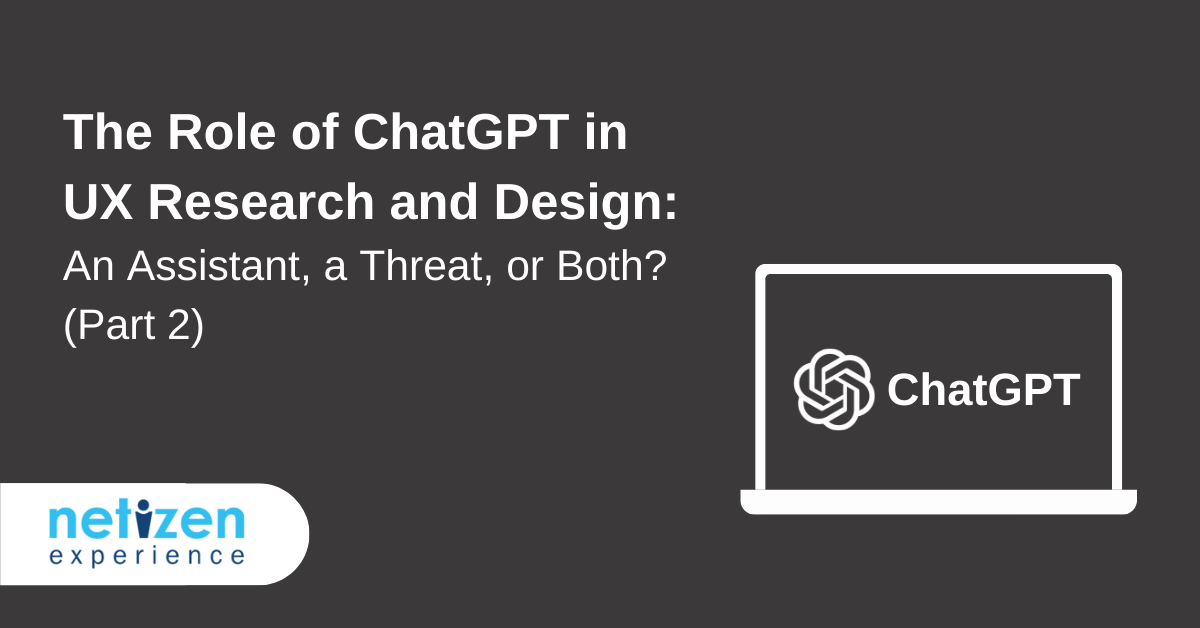The impressive capabilities of ChatGPT, as detailed in our previous article, does not stop at assisting with UX research. Many UX designers have also begun to make use of ChatGPT in their daily tasks. While some view ChatGPT as a powerful tool that can enhance the efficiency of UX design, others fear that it may pose a threat to human creativity and expertise. As the debate continues, it is important to explore the benefits and limitations of ChatGPT in UX design.In this article, we will delve into the influence of ChatGPT on UX design, along with its drawbacks and the implications of incorporating AI tools into the design process.
ChatGPT for UX design
What can ChatGPT do in UX design? Following the previous scenario:You are a UX professional in a tech company trying to create a new hotel booking application in Malaysia. Upon learning what ChatGPT can do, you are excited to incorporate ChatGPT in your workflow to see how it boosts productivity.
UX Design Ideation
1. Design Inspirations
ChatGPT can serve as a valuable source of inspiration for UX designers. It provides helpful references for successful designs or suggestions for improvements. Although the model cannot generate readily-usable designs, wireframes or prototypes, it can guide designers in the right direction. Specifically, ChatGPT can suggest sections to include in a page or essential features for an app.For instance, when designing a hotel-booking app, designers can turn to ChatGPT for guidance and inspiration, asking for suitable app suggestions and design references, including recommendations for typography and logo design.Prompt“I'm creating an app for a hotel-booking app based in Malaysia. Can you give me suggestions of any hotel-booking websites with good usability?”
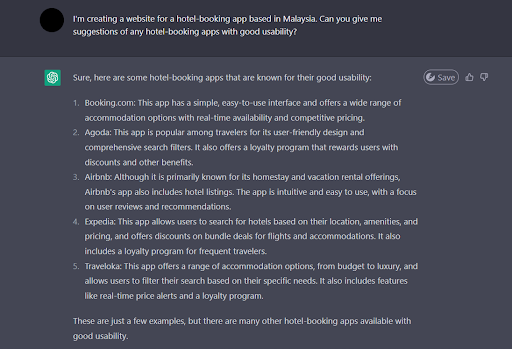
2. Create Design Systems
A design system is a crucial tool that helps designers maintain brand consistency and coherence within a team. It encompasses a wide range of guidelines, components, and assets, such as typography, color schemes, user interface elements, and interaction patterns.When designing app components, designers may encounter situations where they need more detailed guidelines or design systems to draw from. In such cases, ChatGPT can be a valuable resource, providing specific answers relating to design systems that not only offer insights on best practices and principles, but also suggest color schemes, layouts, and other design elements that are relevant to the context and needs of the product.Moreover, if the response generated by ChatGPT is too general or does not meet the designers' needs, they can prompt for more specific adjustments to any design element. By leveraging ChatGPT's capabilities, designers can save time and improve their design quality.Prompt“Are there any recommended design systems that I can follow while designing my hotel-booking app?”
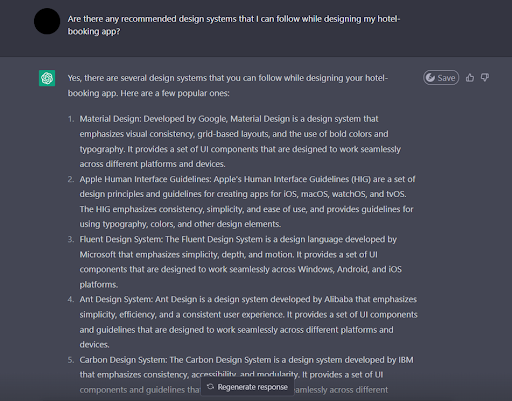
3. Visualize User Flow
User flow comprises information of how a typical user navigates through a website or an app to complete a given task. This is important for UX designers to visualize how a product is used, hence creating a more intuitive and user-friendly design. Designers can consider using ChatGPT to help create a user flow to better visualize how a typical user would navigate an app.By providing suitable prompts, ChatGPT can generate user flows on how a typical user navigates an app as well as suggest placement of features and content based on the context provided. This helps designers to streamline their design decisions and ensure their decisions align with the user flow, resulting in a better user experience.Prompt“Create a user flow for a hotel-booking app, outlining the steps a user takes to search and book a room.”
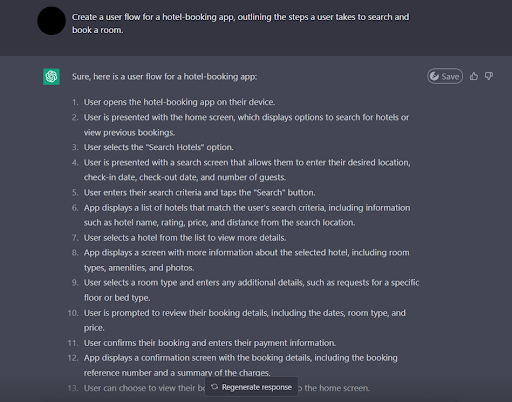
“What are the usual issues faced by users when using a hotel-booking app that I should take note of when designing a hotel-booking app?”
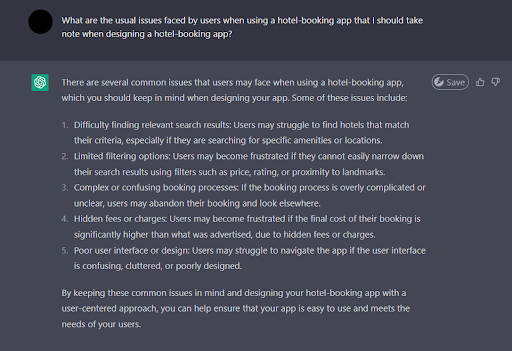
4. Generate Prompts for AI Image Generator
For anyone curious in trying out AI image generators such as DALL-E, Stable Diffusion and Midjourney, ChatGPT can be a valuable tool for generating prompts. By providing specific and detailed instructions on what kind of image you require, ChatGPT can generate a clear and concise prompt that can be easily understood by an AI image generator.Be it the landing page, profile page or even icons for buttons for an app, ChatGPT can generate a prompt that captures the key features that can then be used to guide an image generator to create sample images that can inspire you.Prompt“Make a simple prompt for an AI image generator to generate the profile page of a hotel-booking app”

Limitations
ChatGPT can indeed offer valuable insights and recommendations for design ideation. However, the model’s suggestions rely on existing data and patterns, which can limit the potential for creative, innovative solutions. Despite its ability to generate ideas quickly, its suggestions may not always be unique or groundbreaking. Additionally, ChatGPT may not accurately comprehend the intent or context behind a designer's request, leading to responses that do not align with the designer's creative vision. As a result, designers may still need to supplement with their own creativity to achieve a truly unique and innovative design.The model is also not able to generate directly usable designs. Being a text-based AI, it can only provide suggestions for prompts to be used on other platforms. While these prompts can be helpful for inspiring designers, images generated by AI image generators are often generic and lack the depth and complexity that designers require.
ChatGPT for UX Writing
1. Generate Copywriting
In addition to designing the layout of a platform, it is also important for designers to craft compelling UX copies that effectively convey the intended message and align with the overall brand strategy. With its advanced language-processing capabilities, ChatGPT can help create UX copies that are both engaging and informative, whether it is for writing product descriptions, blog posts or other types of content. By inputting the suitable prompts, the model can help you overcome writer's block and generate fresh ideas that may not have been considered otherwise.Additionally, you could also use ChatGPT to scan your writings and request for suggestions for improvement. Using ChatGPT to generate UX copies can save you time and effort, allowing you to focus on other aspects of your app design or development.Prompt“Give me 5 suggestions of a welcome text description for a landing page of a hotel-booking app.”

“Help me scan this copywriting and give suggestions to improve it:Looking for your next adventure? Our hotel booking app has got you covered with top-rated hotels and resorts in Malaysia.”
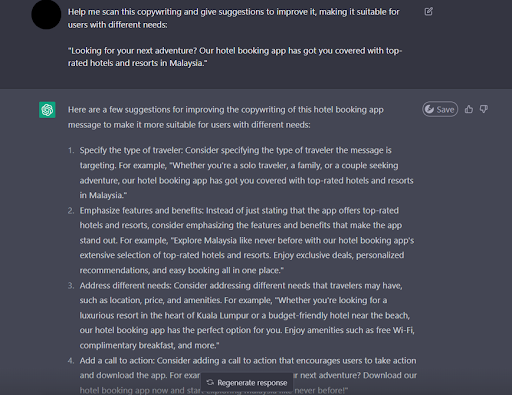
Limitations
However, as advanced technology as ChatGPT, its accuracy in understanding and generating emotional content may be limited. As an AI model, ChatGPT lacks the ability to truly empathize with human emotions and may not be able to capture the subtle nuances of emotional language that a human copywriter would. In addition, ChatGPT's reliance on past data means that it may not be able to respond appropriately to new or unique emotional contexts.While ChatGPT can be a useful tool in generating copywriting, it is important to use it with caution and supplement its output with human input to ensure that the emotional content is accurate and resonates with the intended audience.
Design Review
1. Review Design Ideas
ChatGPT can also be an incredibly valuable tool for UX designers when they are formulating ideas or reviewing a finished product. It offers suggestions, feedback, and asks relevant questions that help designers refine and improve their design ideas. With ChatGPT, designers can easily test different design elements, gain insights to common usability issues, and receive helpful suggestions for improving their designs.For instance, you can provide the URL to a website or even a prototype and request ChatGPT to review and provide critiques related to design flaws. This helps you steer clear of any major usability issues and allow iterations during the design process. Interestingly, you can even prompt ChatGPT to voice their critiques in the style of a certain person or character.Prompt“Imagine yourself as a UX specialist. Give critiques on the design of this app: MakeMyTrip.”

Limitations
Although ChatGPT is a powerful tool for reviewing UX design products and ideas, it may not be able to fully grasp the artistic aspects of a design. Visual elements such as color, typography, and layout play a crucial role in how design is perceived by users. It is important to note that while the model can provide high-level feedback on these visual elements, a human designer's understanding of these elements may still be necessary to provide more comprehensive and detailed feedback that can assist designers in refining and improving their designs. Despite its advanced capabilities, ChatGPT's feedback should be considered as an additional tool for designers rather than a substitute for human expertise.
The Big Picture: Nothing Beats Human Touch
All things considered, ChatGPT can be an invaluable tool in enhancing the UX design workflow. However, similar to its limited capabilities to understand emotions and filter out biased data, the model also has its limitations when it comes to the design process.
1. Design recommendations lack specificity
ChatGPT's responses are often broad and generic, which can limit its usefulness to the design workflow. UX designers often require precise and specific guidance on design elements such as placement and color codes, which may be beyond the scope of ChatGPT's capabilities. Besides, the model may not take into account important design factors such as branding guidelines, accessibility requirements, or user testing results, all of which are crucial elements when designing user-friendly products.
2. Incapable of creative thoughts
As an AI model, ChatGPT relies on analyzing logic and patterns from the data in its database. While it can produce responses that seem intriguing, it lacks the capacity to generate fresh and innovative ideas. In essence, ChatGPT analyzes "how things were done," but does not explore alternative approaches to problem-solving. This limitation hinders its effectiveness in product design, where creativity is often necessary to deliver unique and engaging user experiences.
Final thoughts
Once again, will ChatGPT fully replace human UX researchers and designers?The answer is NO.Although ChatGPT is an effective tool, the model is by no means a replacement for human researchers and designers who possess a deep understanding of human behaviors and can provide nuanced insights machines cannot.Nevertheless, this does not mean that we should stop using ChatGPT prompts for UX design altogether. Instead, integrating AI tools into UX workflows, researchers and designers alike can create better user experiences, which in turn can enhance business value and user satisfaction.



